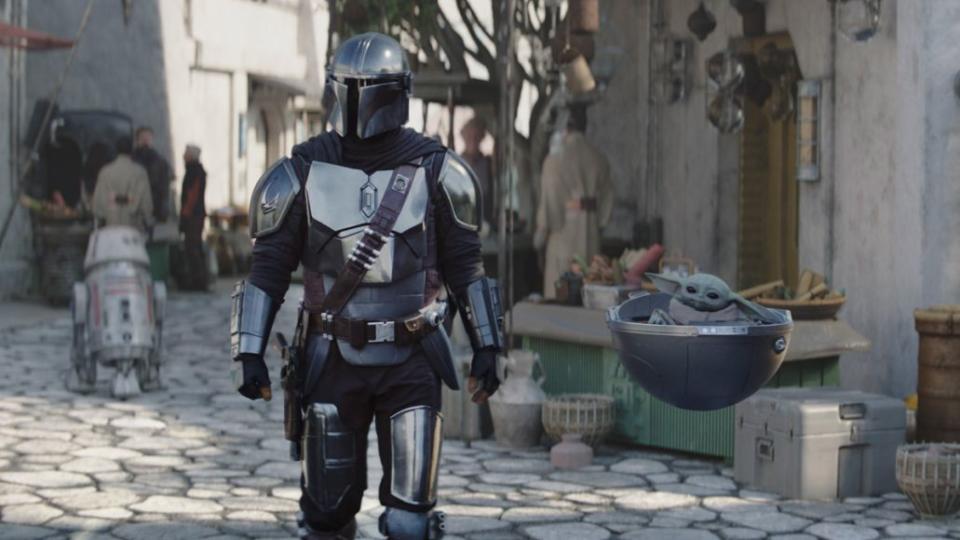The Mandalorian May Be Entering Its Flop Era in Season 3: Review
- Oops!Something went wrong.Please try again later.
The post The Mandalorian May Be Entering Its Flop Era in Season 3: Review appeared first on Consequence.
Season 3 of the Star Wars series The Mandalorian has begun, meaning that the galaxy’s favorite bounty hunter/adoptive dad and his adorable son are back: As set up by the end of The Book of Boba Fett, the Mandalorian known as Din Djarin (Pedro Pascal) and young Grogu (still feels weird to call him that) have been reunited, with Din now committing to full-time parenting of his smol but powerful son.
Din does have another mission, though — having removed his helmet in front of other people back in the Mandalorian Season 2 finale, he’s been officially designated an “apostate” by his religious order (the season premiere just so happens to be titled “Chapter 17: The Apostate”). The only way to get back in good standing is, according to Din’s old acquaintance the Armorer (Emily Swallow), to swim in the living waters beneath the mines of Mandalore, and so that’s just what Din’s going to do — despite the fact that as far as anyone knows, the planet in question’s been bombed to hell. As we’ve seen in the past, though, Din’s a pretty determined guy…
Without getting into spoilers, the first two episodes provided to critics reflect a troubling start to the Emmy-nominated series’ return, primarily because they reveal the flaws often lurking beneath the storytelling. Both episodes feature the same creature fun and space hijinks that are Star Wars signatures. Unfortunately, what they lack is the momentum of the previous two seasons, as Din Djarin’s quest to restore his status as a true Mandalorian is… not exactly a quest as urgent as “save Baby Yoda from Giancarlo Esposito!”
It’s not that The Mandalorian was ever a very plot-heavy show — as led by executive producers Jon Favreau and Dave Filoni, it’s a series that loves its interludes, whether it be an episode where a small village defeats a relic of the Empire, or an episode where Din ferries a frog lady and her eggs to a new home. But while the first two episodes of Season 3 do introduce some potentially key plot threads, moments destined to be included in a future “Previously on The Mandalorian…” the focus of the story thus far is on this aforementioned pilgrimage.
A character’s motivation is a pretty fundamental building block of storytelling, so perhaps it’s a bad sign that as Din goes on his single-minded quest to atone for the sin of taking off his helmet, every other character tells him he’s being ridiculous.
Religious devotion can work as motivation, of course. Have you heard of this book called The Bible? There are a few examples there. However, we’re talking about a space religion about which the casual viewer may know very little; certainly not any more than what’s been explained in the show, which is not much.

The Mandalorian (Disney+)
The series has provided a basic-level understanding of why Din is so dedicated to “the way” — brought into the order as a foundling after losing his family, he found a place to belong. But details about the tenets of this faith, which would give Din’s choices extra meaning, are lacking. We know that Mandalorian tradition is what keeps the helmet on, but we don’t really know why it’s a significant, or symbolic, choice.
Lurking in the background here is the non-story reason for why Din stays faithful to the Mandalorian creed — a helmet-less Mando means that Pedro Pascal has to actually be on set for production, and he’s been busy lately. It’s been known since Season 1 that the show uses stand-ins for the character when Pascal is unavailable, and one nice change for Season 3 is that Brendan Wayne and Lateef Crowder (who have been doubling the role from the beginning) are now listed in the main credits at the end of the show as co-stars.
That’s great news for Wayne and Crowder, of course, but The Mandalorian still has to contend with a series protagonist whose face can’t be seen because of commitments to other projects an adherence to a religious order so extreme the other characters refer to it as a cult. If the helmet were just an affectation, something he likes wearing, it’d be easier to brush this off — but the story has centered in on this aspect of the character so intensely that it’s hard to overlook, especially since at this point not much else is going on.
The first two episodes of the season are not boring — nothing that includes droids and laser blasters and space pirates and Carl Weathers and Amy Sedaris and some relatives of Babu Frik could ever be guilty of that crime. There’s plenty of time to course-correct as the season goes, as well — the show’s already promising some Jedi appearances in episodes to come. However, things feel rudderless at the moment, in search of a destination beyond Din’s pilgrimage, in ways that seem to shout about how thin the show now feels.
It definitely doesn’t help that our memories of Andor Season 1 are still pretty fresh, and that series proves to be a very hard act to follow. Timeline-wise, the two shows are set several years apart (Andor taking place prior to the events of A New Hope, Mandalorian starting off in the period directly following Return of the Jedi) but creatively couldn’t be more separate. Andor is fiercely committed to using Star Wars to say something about our world. But while the show’s surface-level pleasures remain a treat, it’s hard to hear what The Mandalorian is trying to say.
New episodes of The Mandalorian premiere Wednesdays on Disney+.
The Mandalorian May Be Entering Its Flop Era in Season 3: Review
Liz Shannon Miller
Popular Posts

